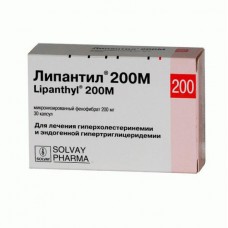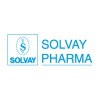Expiration date: 11/2026
Capsules. 1 capsule contains:
the fenofibrate micronized 200 mg
excipients: sodium lauryl sulfate lactose starch prehelatinized magnesium crosspovidone titanium stearate iron dioxide gelatin oxide
blistere in 10 PCs. in cardboard pack 3 blisters.
Description of dosage form:
Hard gelatin capsules of light brown color.
Characteristic:
Derived fibroevoy acid.
Pharmacokinetics:
The main metabolite is fenofibric acid. After taking the drug inside C max in plasma is reached after 5 h. When taken in a dose of 200 mg, the average plasma concentration is 15 mcg/ml. the concentration of drug in plasma is stable. T1/2 fenofibric acid — about 20 hours write mainly with urine (fenofibrinova acid and its glucuronide) after 6 days. Do not cumulate when taking a single dose and prolonged use. Fenofibrinova acid is not displayed in hemodialysis.
Description of pharmacological action:
Lowers triglyceride levels and, to a lesser extent, — cholesterol in the blood. It helps to reduce the content of VLDL, to a lesser extent-LDL, increase the content of anti-atherogenic HDL. Activates lipoproteinlipazou and thereby affects the metabolism of triglycerides impairs the synthesis of fatty acids and cholesterol, promotes increase in the number of LDL receptors in the liver. Phenofibrate reduces platelet aggregation, reduces elevated levels of fibrinogen in plasma, may slightly lower blood glucose in patients with diabetes, reduces uric acid in the blood.
Clinical pharmacology:
Reduces total blood cholesterol by 20-25%, blood triglycerides-by 40-45% and uricemia-by 25%. Long-term effective therapy reduces extravascular cholesterol deposits.
Indications:
Hypercholesterolemia (type IIA), endogenous hypertriglyceridemia (types: IIb, III (isolated and mixed), IV), not amenable to correction diet in adults.
Contraindications:
Expressed violations of liver and kidney function, the presence of a history of phototoxic or photoallergic reactions in the treatment of phenofibrates or other similar drugs, especially Ketoprofen, combination with other fibrates, children under 18 years, pregnancy, lactation, congenital galactosemia, lactase deficiency.
Use during pregnancy and breast-feeding:
Contraindicated in pregnancy. At the time of treatment should stop breastfeeding.
Side effect:
Diffuse myalgia, muscle soreness, weakness, and (in rare cases) — rhabdomyolysis, sometimes — severe. Upon termination of treatment, these phenomena are usually reversible.
From the gastrointestinal tract: dyspepsia. Increased level of liver transaminases activity in blood serum.
Allergic reactions: rarely - skin rashes, itching, urticaria, photosensitization. In some cases (after several months of application) may develop photosensitivity reactions in the form of erythema, papules, bubbles or eczema rashes.
Drug interaction:
Combinations that are contraindicated: with other fibrates - increased risk of side effects (muscle damage).
Undesirable combinations: with HMG-COA reductase inhibitors - increased risk of side effects (muscle damage).
Combinations that should be used with caution - with indirect anticoagulants (risk of bleeding). More frequent monitoring of PV is necessary during the selection of the dose of indirect anticoagulant during the treatment with fibrates and within 8 days after their cancellation.
The fenofibrate is not used concurrently with MAO inhibitors.
Dosage and administration:
Inside with food. The recommended dosage (unless otherwise prescribed by the doctor) is 1 caps. per day. The course of treatment is determined by the doctor.
Overdose:
Treatment: symptomatic therapy.
Precautionary measures:
There are reports of the effect of fibrates on muscle tissue, including rare cases of necrosis. These processes often occur at a reduced level of plasma albumin. This effect should be taken into account in all patients with diffuse myalgia, muscle soreness and with a significant increase in the level of creatine phosphokinase (5 times higher than normal). In these cases, treatment should be discontinued.
In addition, the risk of muscle damage may be increased if the drug is prescribed with HMG-COA reductase inhibitors.
Due to the presence of lactose, the drug is contraindicated in congenital galactosemia, glucose and galactose malabsorption syndrome or lactase deficiency.
If the application of the drug for 3-6 months was not received a satisfactory decrease in serum lipids, should be provided a different therapeutic approach.
It is necessary to systematically monitor the level of hepatic transaminases in the blood serum every 3 months during the first 12 months of treatment. If the level of AST and ALT is increased by more than 3 times compared to IOP, treatment should be discontinued.
When combined with indirect anticoagulants requires careful monitoring of blood coagulation.


